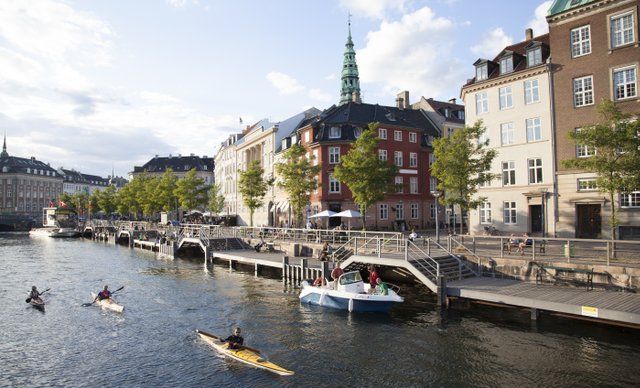Today is the last day of the green tripartite negotiations to agree a carbon tax on Denmark’s agricultural emissions.
To hit its target of a 70 percent greenhouse-gas reduction in 2030 and climate neutrality in 2045, Denmark needs to bring down emissions in the agriculture sector.
Without intervention, agriculture is projected to account for 46 percent of Denmark’s greenhouse gas emissions in 2030.
A tax for landowners, calculated per tonne of greenhouse gases emitted by agricultural activity, has therefore been pushed forward as the solution.
In February, an expert committee of economists presented three potential taxation models to the green tripartite group for negotiations.
The group – comprising Agriculture and Food, the Danish Nature Conservation Association, Danish Industry, Danish Metal, the food association NNF, the National Association of Municipalities and the government – has been engaged in those negotiations since.
Now, the final proposal is due. But according to Altinget, sources close to the group say they are far from reaching an agreement.
What’s at stake?
Interests are divided: Agriculture organisations say a tax will disproportionately impact the personal economies of landowners, who already battle razor-thin margins, and who can’t afford to pay for expensive new farming approaches and technologies necessary for the green transition.
Meanwhile, nature organisations and other industry groups have called for agricultural production to be taxed at the same level as other industries – the equivalent of DKK 750 per tonne of greenhouse gas emissions (CO2e).
It’s only fair, they say: according to 2020 figures from the ecology NGO Økologisk Landsforening, Danish farms emit some 10.6 million tonnes of CO2 annually.
That load is equivalent to 22.4 percent of the country’s total carbon emissions, compared with 15.6 percent ten years ago – a share which has increased as other sectors have reduced their emissions.
The starting point for the green tripartite negotiations is three taxation models, developed by an expert group of economists – the so-called Svarer committee.
Each model presents a different tax per tonne of CO2e, between DKK 250 and 750, combined with various proposed subsidies for farmers.
According to the predicted climate, social and economic outcomes, the models are expected to reduce emissions by between 2.4 and 3.2 million tonnes by 2030.
What’s decided? What’s left to decide?
Several “potentially major changes” for the climate, environment, farmers and the Danish countryside are on the table, reports Altinget.
According to the media’s unnamed sources, it’s the DKK 750 tax, or one of the Svarer committee’s two intermediate variants of just over DKK 300, that are likely to form the basis of the agreement.
But an agreement is far from falling into place, and answers to the biggest questions are still pending:
How big will the tax be? When and how will the tax come into force? Several sources say that the group did not begin discussing concrete price levels until last week.
A significant part of the negotiations are also about fulfilling Denmark’s plan to plant 250,000 hectares of new forest as an emissions sink, biodiversity boost, and to ensure cleaner drinking water.
But how much farmland will be reforested as part of the plan is undecided. So too, is how much landowners will be compensated for giving up that land.
According to several sources, there is a land fund on the drawing board, “for an undisclosed double-digit billion amount”, that would help the state to buy up agricultural land.
The impacts of this kind of land transition would be huge. Farmland makes up over 60 percent of Denmark’s total area. Together with Bangladesh, Denmark is the most cultivated country in the world.
Spanner in the works
In April, a spanner was thrown into the works when a new study by the University of Copenhagen evaluated that Danish forests would absorb a significantly greater volume of CO2 in the future than had previously been predicted.
Since agriculture and forestry belong to the same category in the climate accounts, those 1.7 million tonnes of ‘saved’ CO2 reduced the agricultural sector’s shortfall in relation to its 2030 target, and moved the goalposts for the climate tax negotiators.
According to Professor Michael Svarer, the tripartite had three options: Lower the agriculture tax, postpone the phase-in, or aim for an even more ambitious green target.
In May, Climate Minister Lars Aagard compounded the debate further, by calling for the agriculture sector’s Nitrogen pollution to be considered in the overall package.
Nitrogen is a crucial nutrient that helps plants and crops grow, and a key component of fertilisers.
But when excess nitrogen from agricultural sources leaks into rivers, lakes and marine waters, it overstimulates the growth of algae, causing oxygen depletion, suffocating plants and animals and turning thriving seabeds into bleached graveyards.
The condition, known as hypoxia, has now become so widespread in Denmark that, in the autumn of 2023, Aarhus University researchers investigating the damage declared the ”worst oxygen-depletion for 20 years”.
The Climate Minister pointed out that to include Nitrogen along with CO2-equivalent greenhouse gases in the green tax on agriculture would clean up the marine environment at the same time as the atmosphere.
“There is a synergy between these things, and the green tripartite must of course consider that, because it’s great to kill one bird, the climate – but imagine if we could kill two birds with one stone. It would be nonsensical not to try,” he told Politiken.
If not included in the tripartite’s agreement, Nitrogen emissions will be addressed after the summer as part of a scheduled review of the government’s 2021 agricultural package.
Is an agreement likely?
With all of this still to address, and only 24 hours to do so, the chairman of the green tripartite Henrik Dam Kristensen has reportedly invited members of the group for breakfast on Thursday morning, if today’s meeting drags on overnight.
Either, Thursday morning will dawn with a historic agreement to tax agricultural emissions on the table – a first in the EU – which will then be submitted to the Folketing for formal adoption.
Or, the deadline will be extended and the heat will be turned up on the tripartite to deliver an agreement. In that case, we may be waiting another week and a half.
















